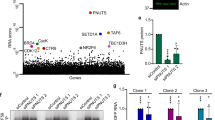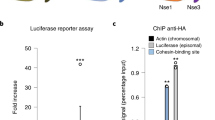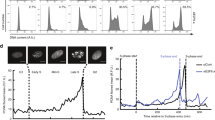Abstract
The E2F1 transcription factor plays a pivotal role in driving cells out of a quiescent state and into the S phase of the cell cycle, in part by transactivating genes needed for DNA replication including DHFR, thymidine kinase, and DNA Polymerase α. E2F1 has also been implicated in regulating an S phase checkpoint, however its role in this checkpoint is not well defined. To determine how E2F1 affects such a checkpoint, we utilized an in vivo replication assay employing a plasmid based SV40 origin of replication, transfected into cells expressing SV40 large T antigen. Here we show that expression of full length E2F1, or only its N terminus, represses replication from plasmids containing the SV40 origin, while N terminal deletions of E2F1 do not. E2F1 appears to inhibit the elongation phase of replication and not the initiation phase since it does not affect the replication of other cotransfected plasmids containing only the SV40 origin. Further, inhibition of replication is dependent on both the amino-terminus of the E2F1 protein and on a DNA sequence that is contained within the 3′ end of the E2F1 cDNA. Additionally, both full-length E2F1, or just its N-terminus, form protein complexes with two portions of the 3′ end of the E2F1 cDNA. These data provide a clue to the mechanism by which E2F1 regulates transit through the S phase checkpoint, by acting on a specific DNA sequence via its amino-terminal region, to inhibit elongation of DNA replication.
This is a preview of subscription content, access via your institution
Access options
Subscribe to this journal
Receive 50 print issues and online access
$259.00 per year
only $5.18 per issue
Buy this article
- Purchase on Springer Link
- Instant access to full article PDF
Prices may be subject to local taxes which are calculated during checkout









Similar content being viewed by others
References
Asano M, Nevins JR, Wharton RP . 1996 Genes Dev. 10: 1422–1432
Ausubel FM, Brent R, Kingston RE, Moore DD, Seidman JG, Smith JA, Struhl K eds . 1991 Current protocols in molecular biology New York: John Wiley and Sons, Inc. p 9.1.1–9.1.7
Bambara RA, Murante RS, Henricksen LA . 1997 J. Biol. Chem. 272: 4647–4650
Blattner C, Sparks A, Lane D . 1999 Mol. Cell. Biol. 19: 3704–3713
Bullock PA . 1997 Crit. Rev. Biochem. Mol. Biol. 32: 503–568
Chittenden T, Frey A, Levine AJ . 1991 J. Virol. 65: 5944–5951
Cortez D, Wang Y, Qin J, Elledge SJ . 1999 Science 286: 1162–1166
Coverley D, Laskey RA . 1994 Ann. Rev. Biochem. 63: 745–776
Dean FB, Borowiec JA, Ishimi Y, Deb S, Tegtmeyer P, Hurwitz J . 1987 Proc. Natl. Acad. Sci. USA 84: 8267–8271
Deb S, DeLucia AL, Baur CP, Koff A, Tegtmeyer P . 1986 Mol. Cell. Biol. 6: 1663–1670
Deb S, Tsui S, Koff A, DeLucia AL, Parsons R, Tegtmeyer P . 1987 J. Virol. 61: 2143–2149
DeGregori J, Kowalik T, Nevins JR . 1995a Mol. Cell. Biol. 15: 4215–4224
DeGregori J, Leone G, Miron A, Jakoi L, Nevins JR . 1997 Proc. Natl. Acad. Sci. USA 94: 7245–7250
DeGregori J, Leone G, Ohtani K, Miron A, Nevins JR . 1995b Genes Dev. 9: 2873–2887
Deng CX, Brodie SG . 2000 Bioessays 22: 728–737
DePamphilis ML . 1993a Ann. Rev. Biochem. 62: 29–63
DePamphilis ML . 1993b J. Biol. Chem. 268: 1–4
Dutta A, Bell SP . 1997 Ann. Rev. Cell Dev. Biol. 13: 293–332
Field SJ, Tsai FY, Kuo F, Zubiaga AM, Kaelin Jr WG, Livingston DM, Orkin SH, Greenberg ME . 1996 Cell 85: 549–561
Hann C, Evans DL, Fertala J, Benedetti P, Bjornsti MA, Hall DJ . 1998 J. Biol. Chem. 273: 8425–8433
Harlow E, Lane D . 1988 Antibodies, A Laboratory Manual Cold Spring Harbor Laboratory, Cold Spring Harbor, NY
Helin K . 1998 Curr. Opin. Genet. Dev. 8: 28–35
Hirt B . 1967 J. Mol. Biol. 26: 365–369
Hsieh JK, Fredersdorf S, Kouzarides T, Martin K, Lu X . 1997 Genes Dev. 11: 1840–1852
Izzo MS, GD Stubbs MC, Hall DJ . 1999 J. Biol. Chem. 274: 19498–194506
Johnson DG, Schwarz JK, Cress WD, Nevins JR . 1993 Nature 365: 349–352
Jordan KL, Evans DJ, Steelman S, Hall DJ . 1996 Biochemistry 35: 12320–12328
Jordan-Sciutto KL, Hall DJ . 1998 Biochem. Cell Biol. 76: 37–44
Kowalik TF, DeGregori J, Leone G, Jakoi L, Nevins JR . 1998 Cell Growth Differ. 9: 113–118
Kowalik TF, DeGregori J, Schwarz JK, Nevins JR . 1995 J. Virol. 69: 2491–2500
Krek W, Xu G, Livingston DM . 1995 Cell 83: 1149–1158
Li S, Ting NS, Zheng L, Chen PL, Ziv Y, Shiloh Y, Lee EY, Lee WH . 2000 Nature 406: 210–215
Logan TJ, Evans DL, Mercer WE, Bjornsti MA, Hall DJ . 1995 Cancer Res. 55: 2883–2891
Logan TJ, Jordan KL, Hall D . 1994 Mol. Biol. Cell 5: 667–678
Marti A, Wirbelauer C, Scheffner M, Krek W . 1999 Nat. Cell Biol. 1: 14–19
Ohtani K . 1999 Front Biosci. 4: D793–D804
Phillips AC, Bates S, Ryan KM, Helin K, Vousden KH . 1997 Genes Dev. 11: 1853–1863
Pyrc JJ, Moberg KH, Hall DJ . 1992 Biochemistry 31: 4102–4110
Sherr CJ . 1996 Science 274: 1672–1677
Shvarts A, Steegenga WT, Riteco N, van Laar T, Dekker P, Bazuine M, van Ham RC, van der Houven van Oordt W, Hateboer G, van der Eb AJ, Jochemsen AG . 1996 EMBO J. 15: 5349–5357
Stillman B . 1994 J. Biol. Chem. 269: 7047–7050
Stillman B . 1996 Science 274: 1659–1664
Stubbs MC, Strachan GD, Hall DJ . 1999 Biochem. Biophys. Res. Commun. 258: 77–80
Yamasaki L, Jacks T, Bronson R, Goillot E, Harlow E, Dyson NJ . 1996 Cell 85: 537–548
Acknowledgements
This work was supported in part by National Institutes of Health Grant CA67032 (To DJ Hall). MC Stubbs was supported in part by a Mary Smith Fellowship. We thank Dr Kristian Helin for supplying the E2F1 cDNA and Dr Wilhelm Krek for the E2F1Δ24 cDNA, and we thank Dr Garry Nolan for use of the Phoenix cell line. We would also like to thank Jason McCormick at the Kimmel Cancer Center, Thomas Jefferson University, for his assistance with the flow cytometry analysis.
Author information
Authors and Affiliations
Corresponding author
Rights and permissions
About this article
Cite this article
Stubbs, M., Hall, D. The amino-terminus of the E2F-1 transcription factor inhibits DNA replication of autonomously replicating plasmids in mammalian cells. Oncogene 21, 3715–3726 (2002). https://doi.org/10.1038/sj.onc.1205473
Received:
Revised:
Accepted:
Published:
Issue Date:
DOI: https://doi.org/10.1038/sj.onc.1205473
Keywords
This article is cited by
-
S-phase-coupled apoptosis in tumor suppression
Cellular and Molecular Life Sciences (2011)



